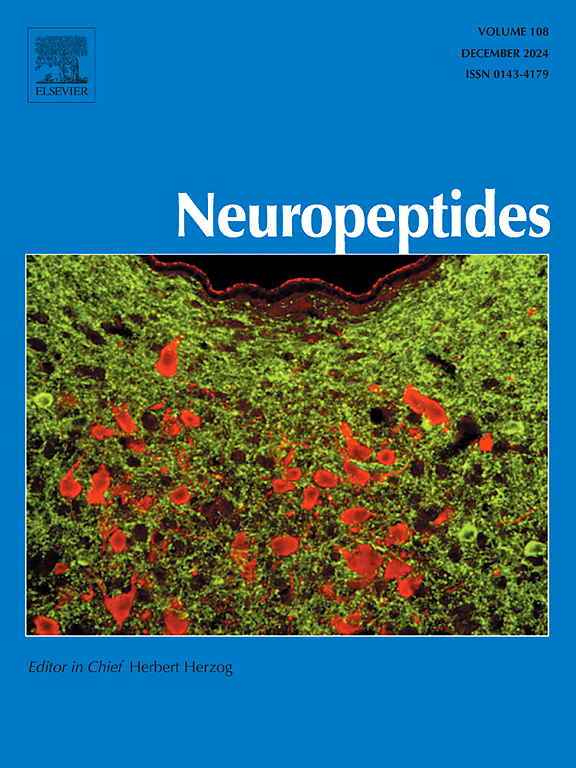Protective effect of TNIP2 on the inflammatory response of microglia after spinal cord injury in rats
IF 2.5
3区 医学
Q3 ENDOCRINOLOGY & METABOLISM
引用次数: 0
Abstract
BACKGROUND Spinal cord injury (SCI) is a devastating disease that can lead to tissue loss and neurological dysfunction. TNIP2 is a negative regulator of NF-κB signaling due to its capacity to bind A20 and suppress inflammatory cytokines-induced NF-κB activation. However, the anti-inflammatory role of TNIP2 in SCI remains unclear. Our study's intention was to evaluate the effect of TNIP2 on the inflammatory response of microglia after spinal cord injury in rats. METHODS HE staining and Nissl staining were performed on day 3 following SCI to analyze the histological changes. To further investigate the functional changes of TNIP2 after SCI, we performed immunofluorescence staining experiments. The effect of LPS on TNIP2 expression in BV2 cells was examined by western blot. The levels of TNF-α, IL-1β, and IL-6 in spinal cord tissues of rats with SCI and in BV2 cells with LPS were measured by using qPCR. RESULTS TNIP2 expression was closely associated with the pathophysiology of SCI in rats, and TNIP2 was involved in regulating functional changes in microglia. TNIP2 expression was increased during SCI in rats and that overexpression of TNIP2 inhibited M1 polarization and pro-inflammatory cytokine production in microglia, which might ultimately protect against inflammatory responses through the MAPK and NF-κB signaling pathways. CONCLUSIONS The present study provides evidence for a role of TNIP2 in the regulation of inflammation in SCI and suggests that induction of TNIP2 expression alleviated the inflammatory response of microglia.TNIP2对脊髓损伤后小胶质细胞炎症反应的保护作用
背景脊髓损伤(SCI)是一种破坏性疾病,可导致组织损失和神经功能障碍。TNIP2是NF-κB信号传导的负调控因子,因为它能够结合A20并抑制炎性细胞因子诱导的NF-κB活化。然而,TNIP2在SCI中的抗炎作用尚不清楚。我们的研究旨在评估TNIP2对大鼠脊髓损伤后小胶质细胞炎症反应的影响。方法在SCI后第3天进行SHE染色和Nissl染色,分析其组织学变化。为了进一步研究脊髓损伤后TNIP2的功能变化,我们进行了免疫荧光染色实验。免疫印迹法检测LPS对BV2细胞TNIP2表达的影响。采用qPCR-方法测定了SCI大鼠脊髓组织和LPS诱导的BV2细胞中TNF-α、IL-1β和IL-6的水平。RESULTSTNIP2的表达与大鼠SCI的病理生理学密切相关,TNIP2参与调节小胶质细胞的功能变化。TNIP2在大鼠SCI期间表达增加,TNIP2的过表达抑制了小胶质细胞中M1极化和促炎细胞因子的产生,这可能最终通过MAPK和NF-κB信号通路保护其免受炎症反应。结论本研究为TNIP2在SCI炎症调节中的作用提供了证据,并表明TNIP2表达的诱导减轻了小胶质细胞的炎症反应。
本文章由计算机程序翻译,如有差异,请以英文原文为准。
求助全文
约1分钟内获得全文
求助全文
来源期刊

Neuropeptides
医学-内分泌学与代谢
CiteScore
5.40
自引率
6.90%
发文量
55
审稿时长
>12 weeks
期刊介绍:
The aim of Neuropeptides is the rapid publication of original research and review articles, dealing with the structure, distribution, actions and functions of peptides in the central and peripheral nervous systems. The explosion of research activity in this field has led to the identification of numerous naturally occurring endogenous peptides which act as neurotransmitters, neuromodulators, or trophic factors, to mediate nervous system functions. Increasing numbers of non-peptide ligands of neuropeptide receptors have been developed, which act as agonists or antagonists in peptidergic systems.
The journal provides a unique opportunity of integrating the many disciplines involved in all neuropeptide research. The journal publishes articles on all aspects of the neuropeptide field, with particular emphasis on gene regulation of peptide expression, peptide receptor subtypes, transgenic and knockout mice with mutations in genes for neuropeptides and peptide receptors, neuroanatomy, physiology, behaviour, neurotrophic factors, preclinical drug evaluation, clinical studies, and clinical trials.
 求助内容:
求助内容: 应助结果提醒方式:
应助结果提醒方式:


